
Photo: The Rabbit Sanctuary
Enrichment is often thought of as an “extra” or optional provision for residents. Sanctuary workers are understandably focused on providing the food, water, and housing that is necessary for residents to live. However, we are hoping that by incorporating enrichment as an aspect of general care, the lives of residents will be enriched. This is of particular importance for residents residing in smaller, more confined, or barren living spaces. In regions that experience intense cold, the best way to keep rabbitUnless explicitly mentioned, we are referring to domesticated rabbit breeds, not wild rabbits, who may have unique needs not covered by this resource. residents warm is to keep them inside. If they are accustomed to having outside access, this can be a big change for them. In cases like these, enrichment can make a world of difference in the lives of residents. No one likes to be bored, including residents, regardless of species!
Developing An Enrichment Plan
The best way to start any enrichment plan is to first consider natural behaviors. For example, in the wild, rabbitsUnless explicitly mentioned, we are referring to domesticated rabbit breeds, not wild rabbits, who may have unique needs not covered by this resource. dig burrows, forage, and gather nesting material for their homes. It’s important to understand both the species-specific needs of your residents in addition to considering their individual needs!
For example of an enrichment plan: On an individual level, Molly, an older little white rabbit, underwent surgery recently and her movements must be limited (particularly her propensity for high jumps) for the next week or two. Setting Molly up with shorter furniture that is low enough for her to safely hop onto and adding treats throughout the living spaceThe indoor or outdoor area where an animal resident lives, eats, and rests. can help her stay active and engaged while she is healing!
When developing an enrichment plan for residents, it’s important to consider the types of behavior in which you’re hoping to see an increase or decrease. For example, do you wish to increase exploratory behavior? Novel objects and nutritional foraging enrichment may be best suited to this task. Do you want to decrease confrontationalBehaviors such as chasing, cornering, biting, kicking, problematic mounting, or otherwise engaging in consistent behavior that may cause mental or physical discomfort or injury to another individual, or using these behaviors to block an individual's access to resources such as food, water, shade, shelter, or other residents. behavior between residents? Consider adding multiple enrichment areas so all residents have an opportunity to access the enrichment, in addition to adding enrichment furniture that can provide visual blocks between residents and the various enrichment spots.
Enrichment Is Well Worth The Time Investment!
We know you have your hands full managing a sanctuary and probably never seem to have enough time. However, developing enrichment plans for species, particular groupings of residents, and individuals can actually help you save time and money in the future! Residents who are provided individualized enrichment are more likely to feel mentally stimulated, experience positive emotions, and are more likely to perform satisfying natural behaviors that can help mental and physical health. Happier residents heal more quickly than stressed individuals, and residents with enriched environments may be less likely to engage in confrontational behaviors, depending on their living space.
Sample Individualized Enrichment Plan
Let’s take a look at an example of an individualized enrichment plan for a rabbit resident.
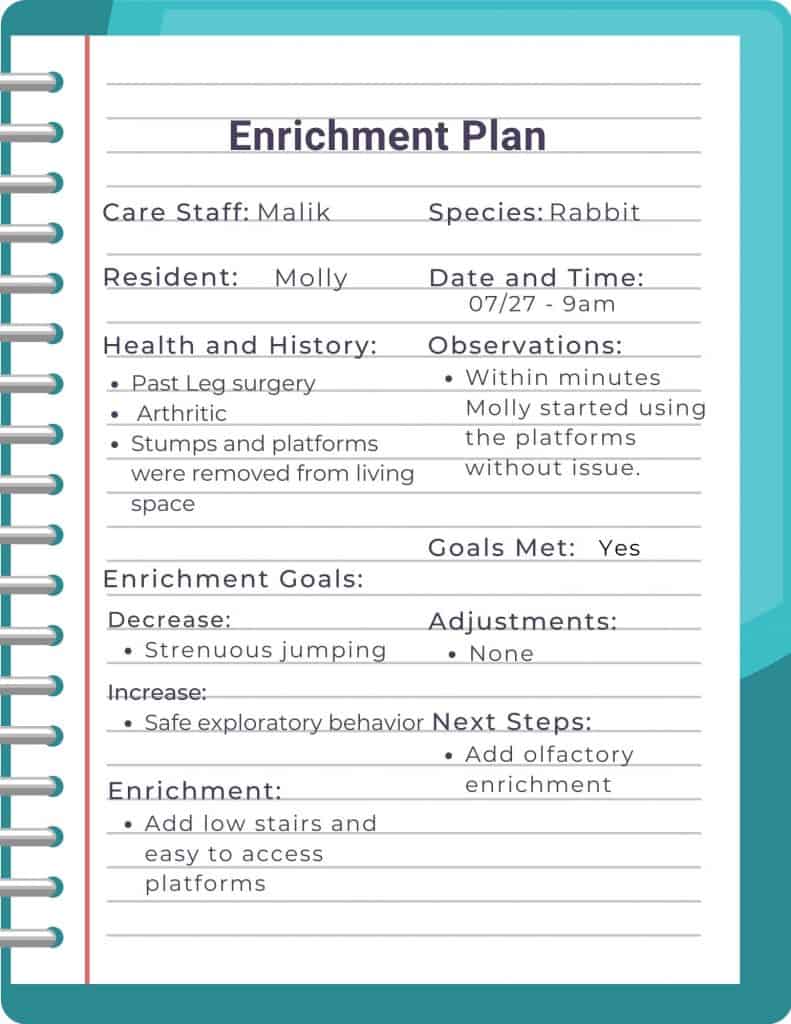
As you can see, enrichment can go beyond just offering toys or treats- and that offering enrichment isn’t just a one-time thing! Residents will become bored with certain enrichment that is left in their living space for an extended period or the same enrichment offered every day (tasty treats being likely an exception to this).
Now that we have covered what an individual enrichment plan looks like, we will cover some of the different types of enrichment for rabbits and how they could be implemented at your sanctuary.
Observations And Adjustments Are Key!
It’s always important to observe if and how residents use the proffered enrichment. Remember, it is only enrichment if the individual finds it enriching! If they are frightened by something or uninterested in it, then it isn’t enriching.
Social Enrichment
This one may seem obvious, but it’s important to mention! Rabbits are generally social animals, and it’s important they have access to other rabbits. Of course, there may be times when this isn’t possible, due to medical issues, resident disagreements, or sadly, the death of their companion. In cases like these where direct contact with others of their species isn’t possible, there are ways that you can enrich their lives during this time:
- Provide visual contact with other rabbits.
- Add a mirror to their living space.
- If they have to be temporarily isolated, Include a small amount of soiled bedding (if contagion isn’t an issue) from their original living space.
- Many rabbits have been known to form strong social bonds with humans. Increasing time spent with an isolated rabbit may be of benefit during separation from their social group.
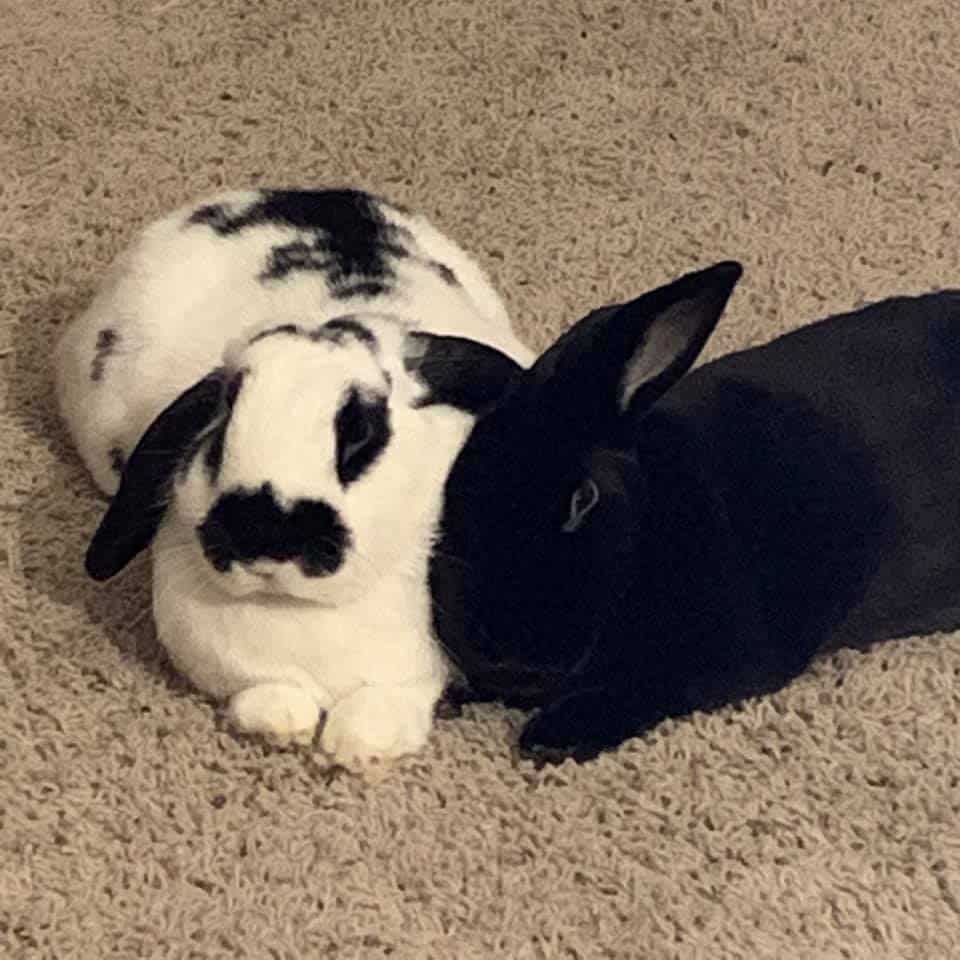
Photo: Great Lakes Rabbit Sanctuary
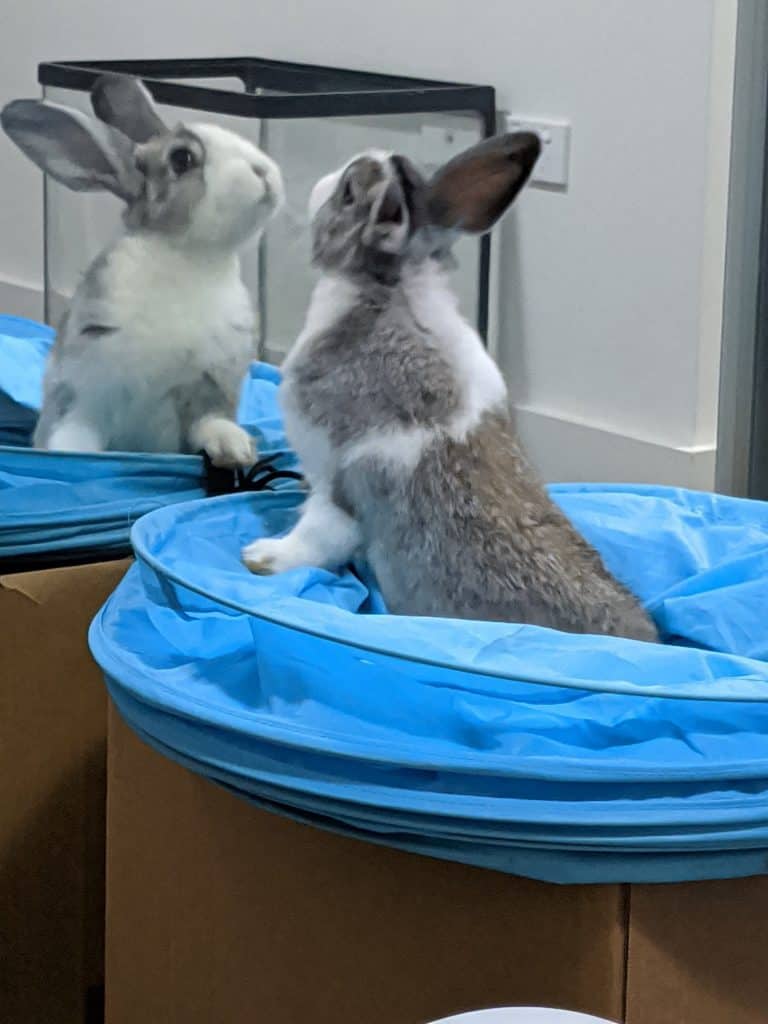
Photo: Great Lakes Rabbit Sanctuary

Photo: Great Lakes Rabbit Sanctuary
Physical Enrichment
Physical or structural enrichment refers to creating a dynamic living space for residents. Structures, furniture, substrates for digging or dust bathing, climbing, hiding, perching (in the case of some feathered friends) are all examples of physical enrichment! Let’s look at some rabbit-specific physical enrichment:
- Provide a dynamic rabbit hidey house that is one or multiple levels, with holes between floors for rabbit residents to explore.
- Hollow logs, large PVC tubing, cardboard carpet rolls, and collapsible tunnel toys all provide rabbit residents with places to hide and explore, similar to a wild rabbit’s warren.
- Cardboard boxes can be made into an edible castle or hidey hole! (Be sure to always create at least two entrances or exits, as this will help residents feel safer using them.)
- Platforms: Rabbits like to climb up on things and survey their surroundings. Including little platforms made out of sturdy wooden boxes, large rocks, stumps, stairs, or solid shelving placed around their living space helps create a dynamic environment.
- Areas with fresh dirt and sand can help provide rabbits with areas to dig. Be careful not to feed residents on sand as they could ingest it, causing an impaction.
- Similarly, a nice dusty spot allows rabbits to have a nice roll in a dust bath!
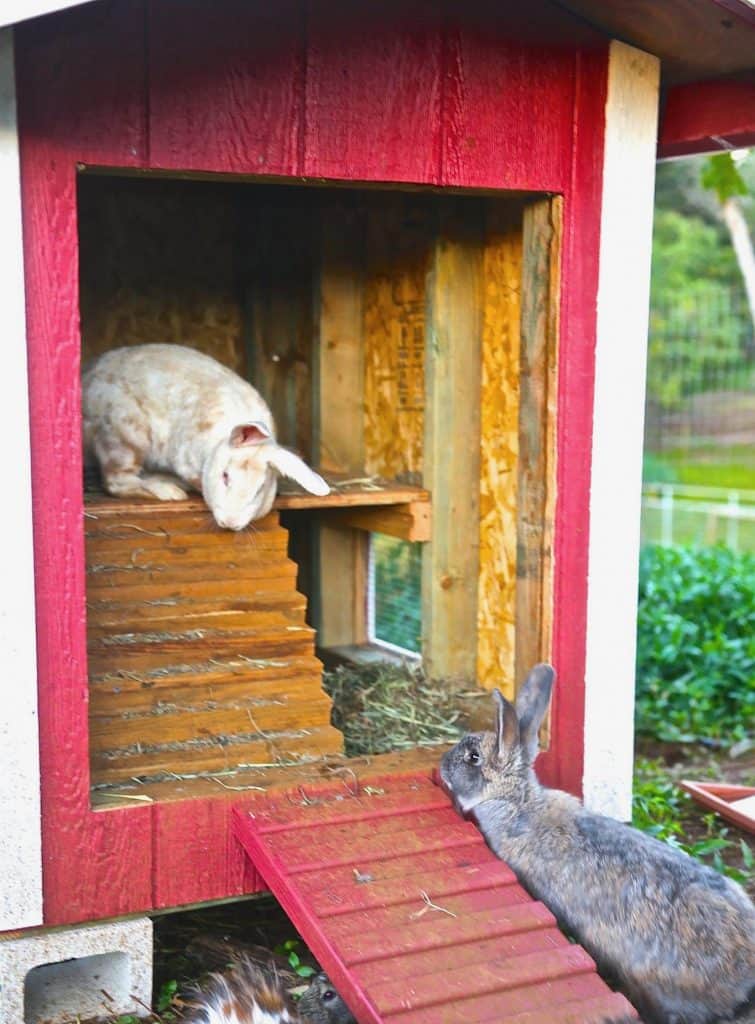
Photo: Leilani Farm Sanctuary
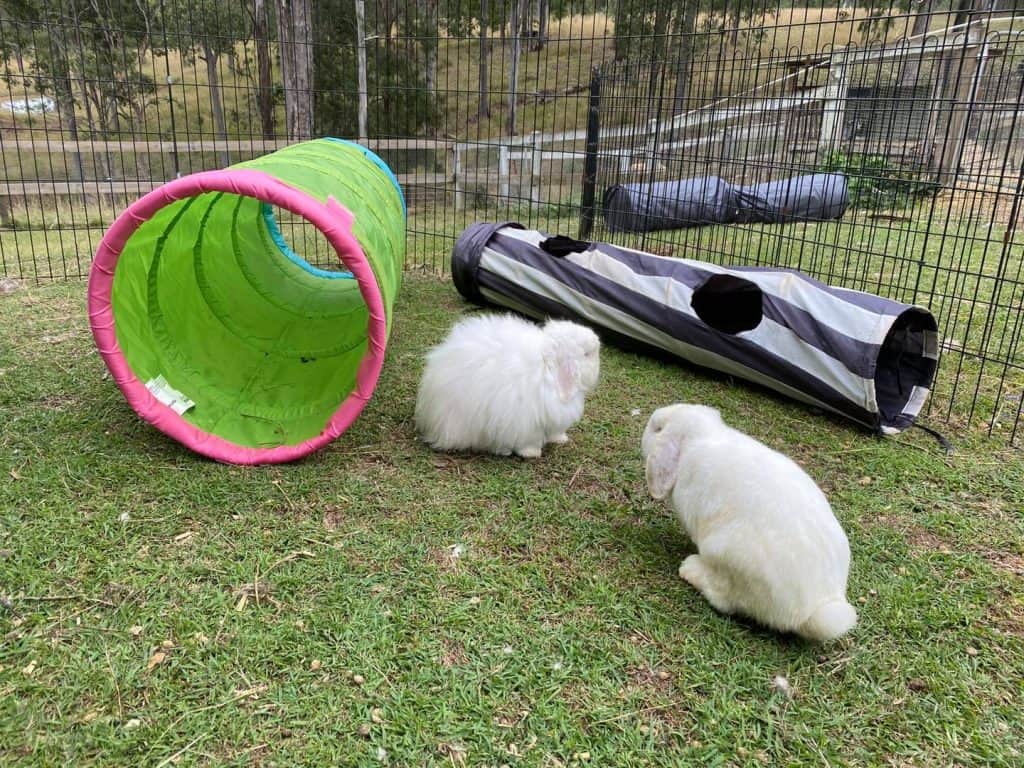
Photo: The Rabbit Sanctuary
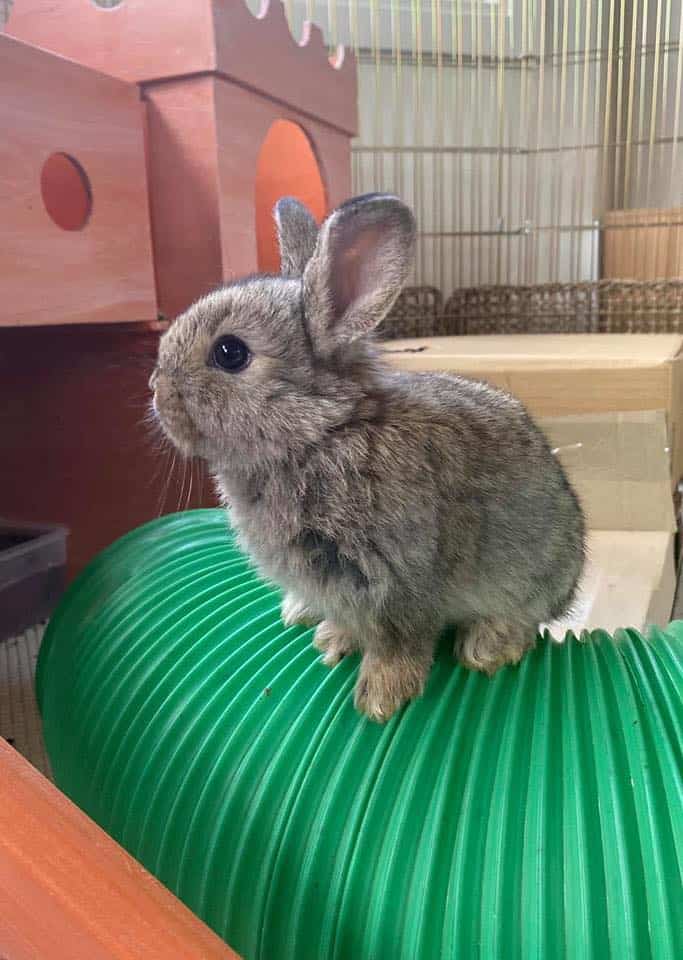
Photo: The Rabbit Sanctuary
Nutritional Enrichment
This is a fun one! We all know rabbits enjoy a good nibble while foraging and enjoy an array of tasty treats.
Here is a list of ideas for nutritional enrichment for your rabbit residents:
- Take a two to three-inch wide PVC pipe and put caps on the ends. The length of the tube could be twelve inches or larger. Drill a handful of holes on the side of the tube, and it becomes a food dispenser when the rabbits roll it.
- Another option is to place rabbit treats in wiffle balls. As the balls roll, treats fall out.
- Some puzzle feeders made for dogs can be used for rabbit residents with supervision. Or make your own!
- Hang greens up high.
- Add a pile of rabbit-safe leaves and sprinkle treats throughout.
- Individual rabbits may exhibit a behavior called contrafreeloading. Contrafreeloading is the term for when an animal will choose to perform a task to receive food even when there is food readily available.
- You may be able to stimulate your rabbit residents into exhibiting this behavior by packing hay into a cardboard box with holes, or hiding treats in an old oatmeal container. Rabbits can solve logic puzzles, and this can be used to promote foraging behavior that requires some effort on their part- to their enjoyment! Small boxes with lids and rabbit-safe material and tiny rabbit sized drawers with rope attached could lead a rabbit to learn to pull on the rope to get the desired treat!
- If you think hiding a rabbit’s food or making them work for their food is unkind, you can try an experiment with your residents: Provide a puzzle with food in it next to a bowl of food, and see how your residents behave towards each. They will tell you if they find the puzzle engaging or not!
- When temperatures are hot, add chopped up produce to a mold, add water and freeze, creating a cool treat that can keep your residents engaged on a hot day.

Photo: Leilani Farm Sanctuary
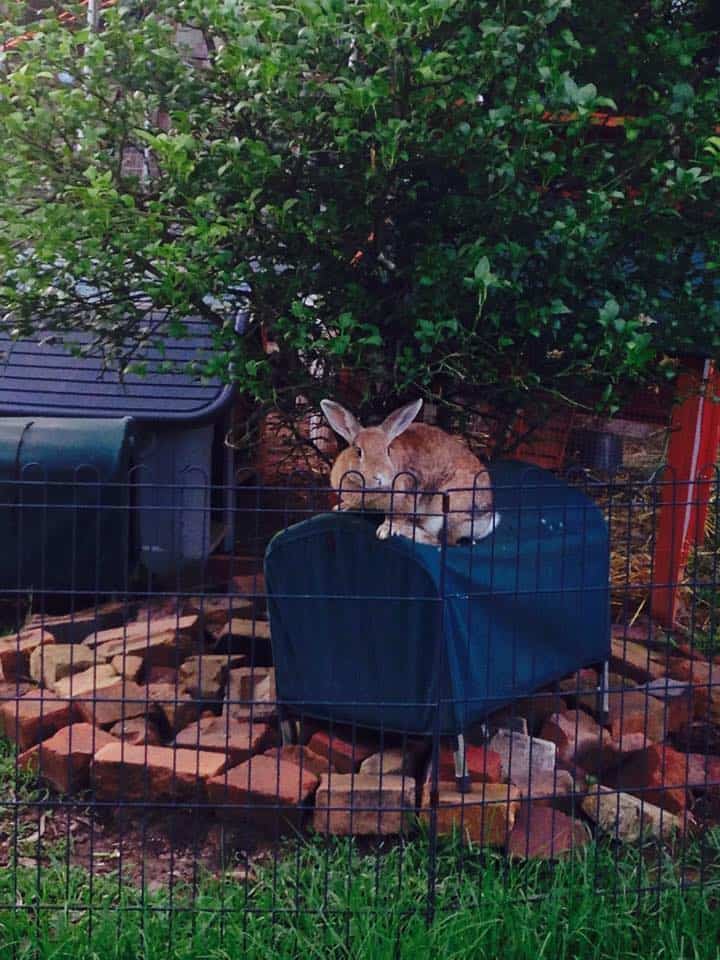
Photo: The Rabbit Sanctuary
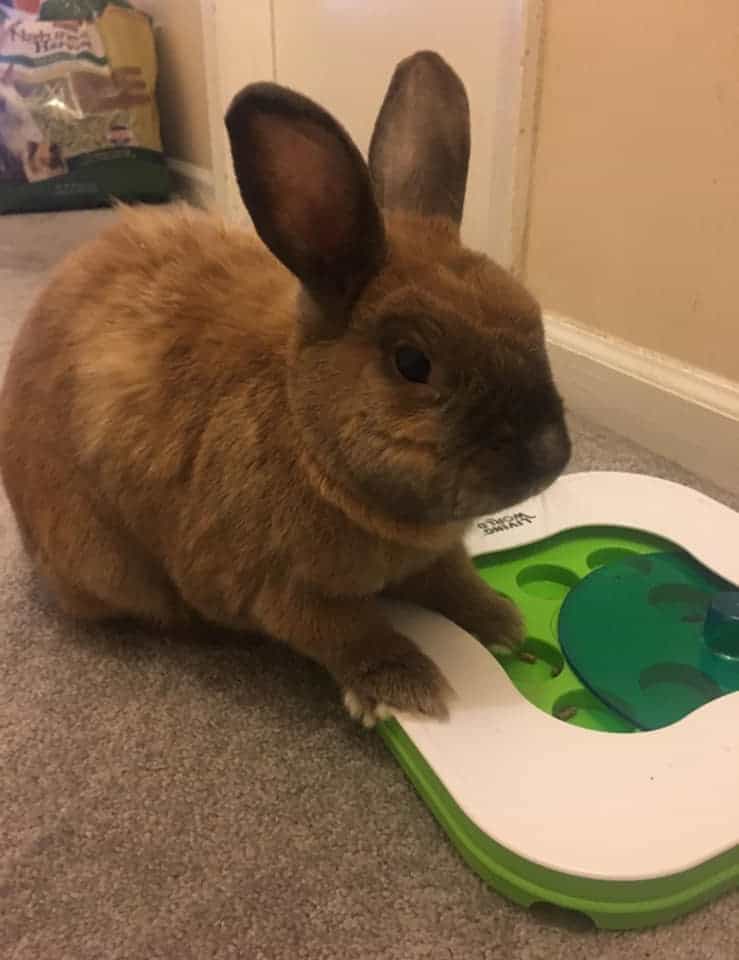
Sensory Enrichment
Sensory enrichment refers to enrichment that engages the senses. Arguably all enrichment engages the senses, but sensory enrichment focuses in on sight, touch, hearing, and smell. Each can provide interesting experiences for rabbit residents!
Visual Enrichment
While there hasn’t been much in the way of research studying the effects of visual enrichment in rabbits, appropriate visual enrichment for rabbit residents may include:
- Showing rabbit residents computer screensavers, particularly those that move.
- Showing residents television or movies.
- Providing access to a window for watching.
- Provide a mirror for residents (if it does not cause them distress).
- Simply adding new items to their living space.
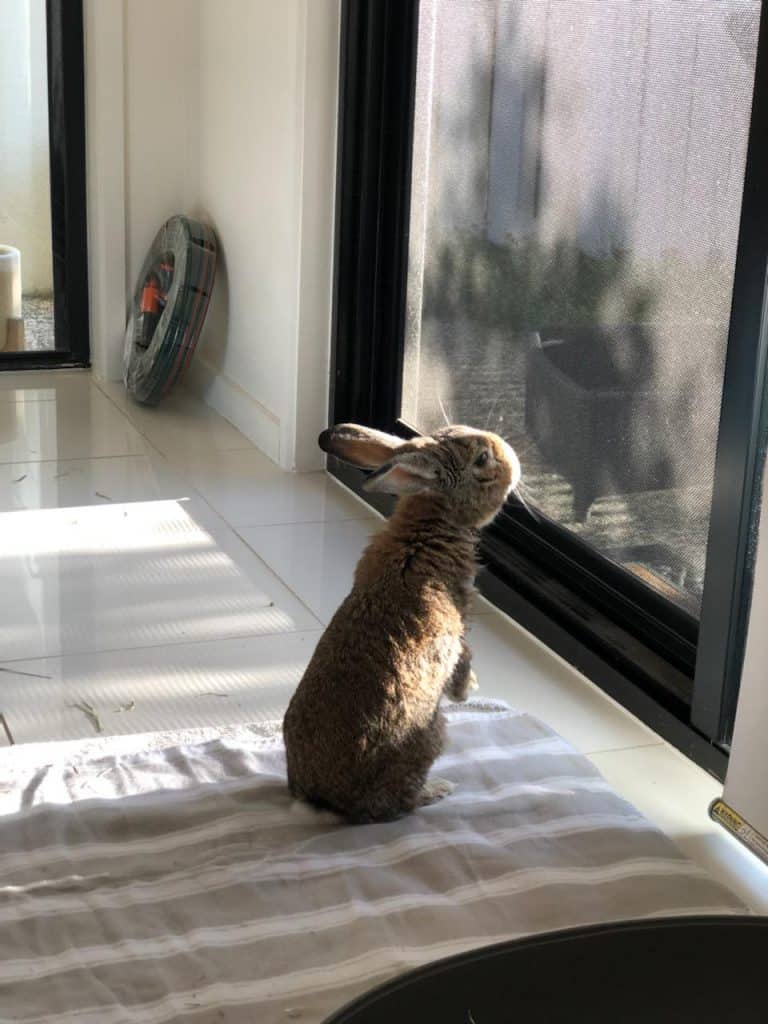
Photo: The Rabbit Sanctuary.
Olfactory Enrichment
Rabbits use their noses a lot! They use their sense of smell to communicate, sense predators, identify family, attract mates, mark territory and find food. This has implications for rabbits in sanctuaries. It provides a useful form of enrichment that can be easily provided by care staff. It also means that, because rabbits have a better sense of smell than humans, staff should consider how strong the scent is they are offering and water it down if possible if it is particularly strong! Strong perfumes or cleaning solutions may also have a negative effect on rabbit residents.
- If you need to transfer a rabbit resident to a new living space, add a bit of soiled bedding from their previous space.
- One study revealed that PetAn animal who spends regular time with humans in their home and life for companionship or human pleasure. Typically a small subset of animal species are considered to be pets by the general public. Remedy spray that contains valerian root had a calming effect on rabbits when they were handled by humans.
- Try adding different fresh herbs around their living space.
- Scent two identical toys with a spritz of watered down essential oil and one without and see if they investigate the one with the scent more closely. Be sure to never directly apply the scents to the resident or provide direct access to essential oils!
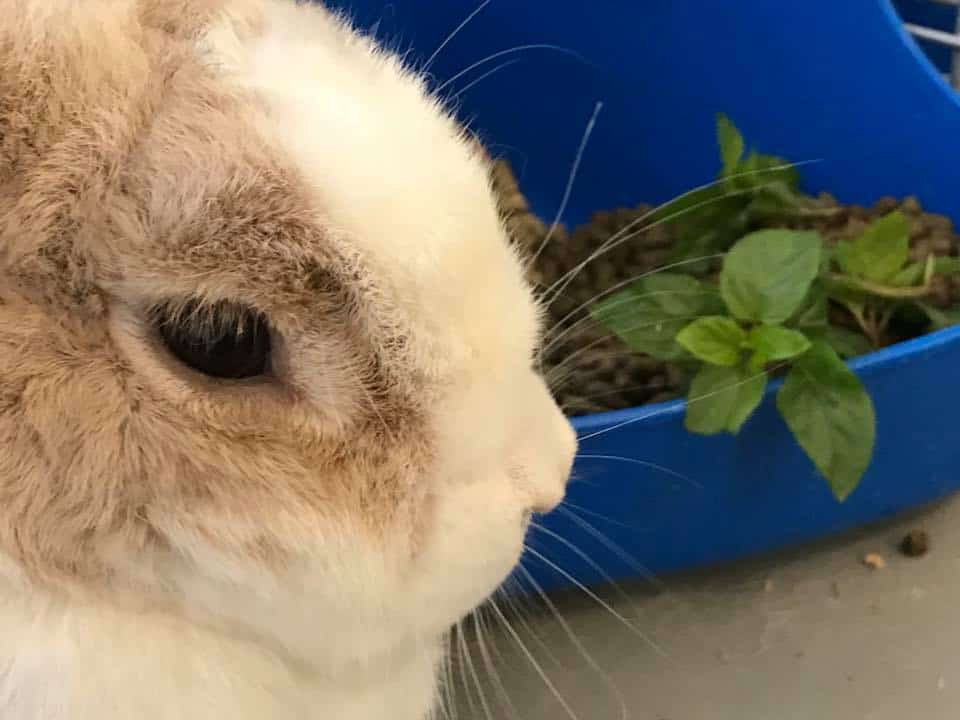
Photo: The Rabbit Sanctuary.
Auditory Enrichment
Do you love a good tune? Or have a favorite song that soothes you? The same can be true for rabbits! Just remember, not too loudly, as rabbit residents are sensitive!
- Rabbits have been shown to experience reduced stress levels when classical music is played for them.
- Other possibilities include calm rain sounds or soothing music.
- Playing the radio is not recommended as you cannot control the sounds, and sudden loud noises can be upsetting to rabbit residents.
Tactile Enrichment
To encourage rabbits to interact with their environment and redirect otherwise problematic behavior, consider adding tactile enrichment to their living spaces. You will start to find that many forms of enrichment overlap! This might include:
- Adding piles of different rabbit-safe substrate like leaves, fresh dirt, sand (Be careful not to feed rabbit residents over sand, as they can ingest it and become impacted.) for them to explore their textures.
- Adding sand or dirt for a nice dust bath can also be stimulating.
- Add toys! Rabbits can enjoy tossing things into the air and even pushing things around their living space. Try giving them hard plastic balls for them to push around, or hard plastic baby toys like keys on a ring and see what they do!
- Chew toys, such as untreated wooden blocks, cardboard boxes, pine cones, strips of untreated pine, willow, or apple branches, and wicker baskets can all be great chewing options for resident rabbits.
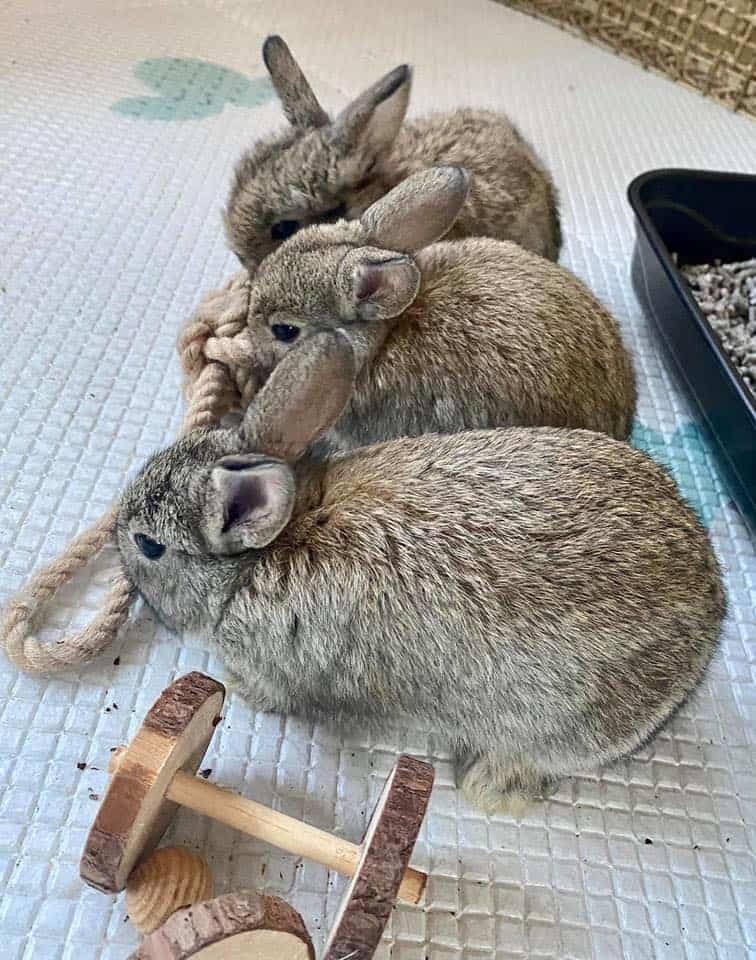
Photo: The Rabbit Sanctuary
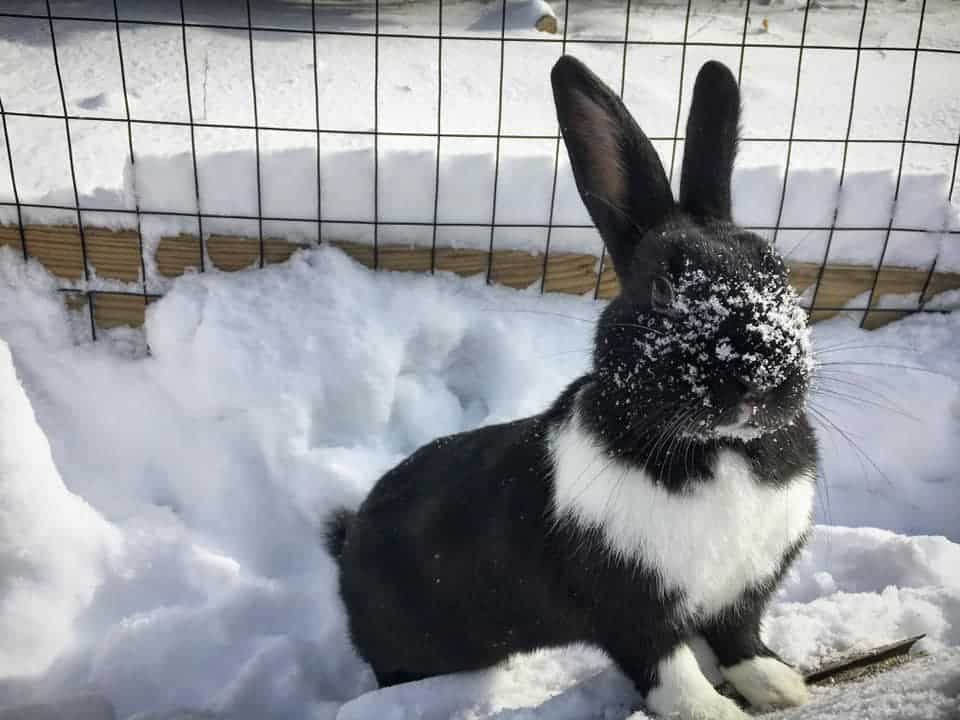
Photo: Great Lakes Rabbit Sanctuary
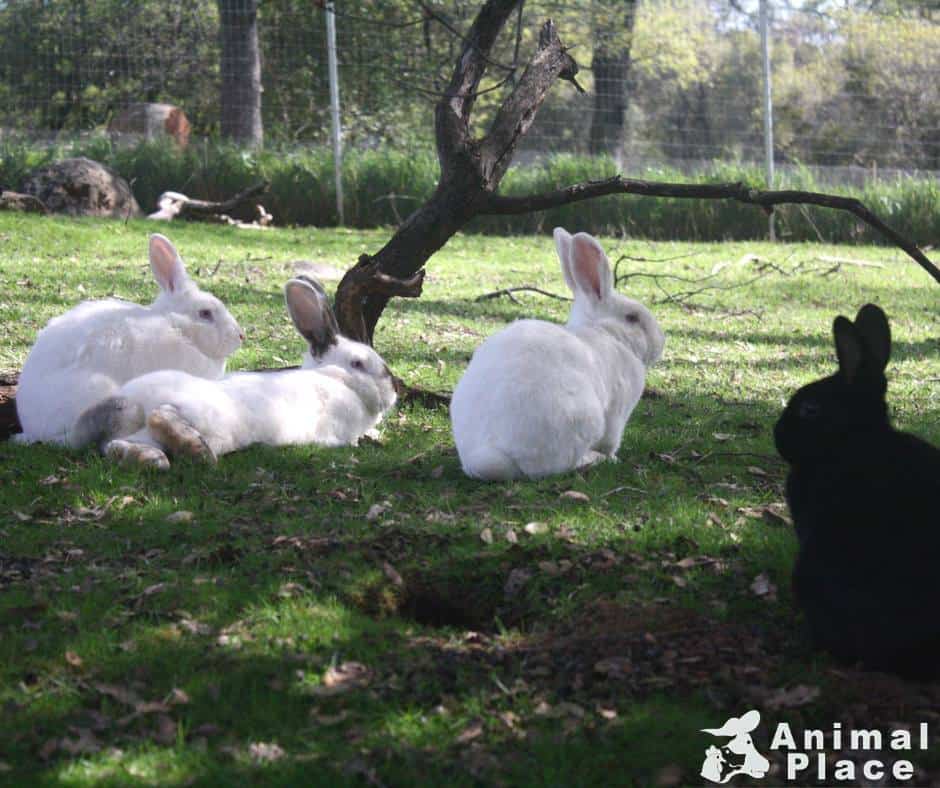
Cognitive Enrichment
Cognitive enrichment involves experiences or environments that encourage curiosity, problem solving behaviors, and learning. A number of enrichment strategies listed above also fall into this category. Puzzle feeders and going on walks in safe areas with a resident comfortable wearing a harness vest are great examples of this. But let’s touch on another form of cognitive enrichment: positive reinforcement learning (This is often referred to as “training”, but we feel “learning” and “engagement” are better descriptions of this in a sanctuary environment.)
- Positive Reinforcement Engagement
- Many rabbits may enjoy interacting with their human caretakers. One way to build a strong human-rabbit bond and boost cognitive functioning in your rabbit residents is to engage in clicker “training” (we prefer the terms “bonding” or “engagement”). Clicker bonding and positive reinforcement are not interchangeable words. However, a clicker can be a useful tool during positive reinforcement engagement!
- Examples of activities to learn with your rabbit residents could include learning to choose a specific shape or color and rewarding them with an immediate click and treat. Other examples include teaching rabbits to come to the call of their name, how to ring a bell, and even move through agility courses. Positive reinforcement can also be used to ease medical procedures and transfers. This external link provides a brief tutorial on how to engage rabbits with a clicker.
Focus On The Resident
It is important to note that clicker learning or play should only be implemented for the positive experiences that can be provided to your residents. This should not be used to encourage behavior that might be unsafe or exploitative.
Take Notes
Because every rabbit is an individual, they are likely to have individual responses to enrichment. When you first add enrichment items, be sure to carefully observe the reactions of your residents. To prevent discomfort to new items or enrichment schedules, consider adding novel objects to an area to the side of their enclosure, or in a space that doesn’t require them walking past the item to go inside, outside, or to reach their water or food. If you believe one of your resident groups or individuals may be fearful of certain enrichment, encouraging them to investigate the object while you are sitting and holding the object can help ease fears. Using food or treats to motivate them to interact with the item is a great way to start. Giving your residents the option to engage or not with enrichment items can be empowering and improve emotional states. Be sure to make notes of any reactions and when their level of interest seems to subside. This will help you know how to best schedule days to change up their enrichment and provide them with a mentally stimulating environment.
Novelty
Novelty can be enriching on its own. However, rabbits can become unsettled by big sudden changes, so care must be taken to slowly add new things and observe the resident(s’) reactions. And never make changes to their meal times or change a diet quickly, as this can have serious health complications. Instead, making changes to the “furniture” arrangement, placement of treats, and the addition of balls and toys can all create an interesting and enriching environment for your rabbit residents. Rabbits are clever and become bored after some time with provided enrichment. For this reason, it is important to incorporate “switch it up” days into your residents’ enrichment schedules!
Building A Schedule
Once you learn more about your residents’ interests, you can build an enrichment schedule to provide varying forms of enrichment as part of your caregiving routine, as well as schedules to replace enrichment. This will keep things interesting for the rabbits and help provide a stimulating and happy life for your residents.
Do you have an exciting enrichment strategy you use with your rabbit residents? Tell us all about it!
SOURCES:
Logic Toys For Rabbits | My House Rabbit
Clicking With Your Rabbit | Karen Pryor Clicker Training
Behavioural Effects Of Environmental Enrichment For Individually Caged Rabbits | Applied Animal Behavior Science (Non-Compassionate Resource)
Effects Of Music Enrichment On Individually Housed Male New Zealand White Rabbits | JAALAS (Non-Compassionate Resource)
Rabbit Preference For Cages And Pens With Or Without Mirrors | Applied Animal Behaviour Science (Non-Compassionate Resource)
A Double-Blind, Placebo-Controlled Trial Investigating The Value Of Pet Remedy In Ameliorating Fear Of Handling Of Companion Rabbits | Journal Of Veterinary Behavior (Non-Compassionate Resource)
Non-Compassionate Source?
If a source includes the (Non-Compassionate Source) tag, it means that we do not endorse that particular source’s views about animals, even if some of their insights are valuable from a care perspective. See a more detailed explanation here.








